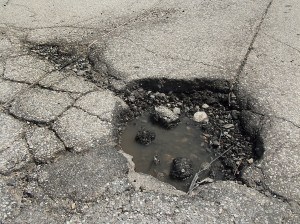New data from the latest Farmers Seasonal Smarts Digest reveals that 60 percent of all comprehensive hail claims occur between March and May. Drivers from California to Virginia, and everywhere in between, should be aware of the potential for hail damage, as Farmers data uncovered a 40 percent increase in hail claims during the past four years.
Farmers Insurance auto claims filed between 2013 and 2016 show that in addition to an increase in hail, drivers across the country should be aware of two other significant spring hazards. More than 40 percent of all flash flood and rising water claims and nearly one-third (30 percent) of wind and tornado damage occur in the spring. While wind and tornado damage has decreased by 23 percent since 2013, flash flooding and rising water claims more than doubled during the same time period.
“Hailstorms occur in all parts of the country and can result in windshield cracks, dents to your car and dangerous driving conditions,” said Paul Quinn, head of claims customer experience with Farmers Insurance. “It’s important that drivers know the warning signs of hail as well as how they can avoid and prevent damage to their vehicles.”
Drivers across the country can prepare for upcoming spring hailstorms by considering the following tips from Quinn:
- Your vehicle will be safest in a garage or under a carport/awning during a hailstorm so use covered parking, if possible. If covered parking isn’t available, you may want to consider a hail blanket or specialized car cover. Make sure all coverings are secure, as the wind associated with hailstorms can blow loose covers away.
- Keep an eye on the color of the sky. A greenish color in the sky is sometimes visible before and during severe weather, including hailstorms, although scientists don’t know exactly why the sky appears green.
- If caught in hail, park next to a building on the same side as the direction the storm is moving. For example, if the storm is in the southwest and moving northeast, parking close to the northeast side of a building may reduce damage.
- Prepare a flood route. Think about alternate routes home ahead of time and make note based on the best possible route that will incur the least possible issues.
Drivers should also be aware of potential hazards that can occur after the storm like dangerous potholes and flash flooding. 
“Once the storm moves through, there can still be unexpected and dangerous driving conditions out on the roads,” Quinn explained. “Water levels can continue to rise even after the rain has stopped. Be cautious of potentially flooded roads and hidden potholes while driving after a storm.”
Quinn offered post-storm driving tips, including:
- Think about familiar routes. Be on guard for potential changes to a frequently used route, watch for changes or unfamiliarity in the roadway. Always proceed with caution and turn around when in doubt.
- Keep an eye out for “covered” potholes. Potholes can fill with water following a storm or when roadside snowbanks melt, which makes them harder to see and their depth difficult to judge. A good rule of thumb is to safely avoid mysterious puddles.
- What goes up, must come down. Be cautious when knowingly traveling on streets with steep hills, there may be a newly formed lake waiting at the bottom of the hill. Always remember that water can continue to rise after the rain stops, water on a road way may be deeper than it appears and there may be more on its way.
- Know where your route will take you. Be aware that drainage channels, underpasses and similar areas are prone to flash flooding, which can occur even if typical warning signs like rain clouds or heavy rain are not present.
- Night driving requires extra awareness. Low light levels make it harder to see potential flood dangers and make drivers more susceptible to accidentally driving into a flooded area.
Source: Farmers
Was this article valuable?
Here are more articles you may enjoy.


 Instacart to Pay $60 Million in FTC Consumer Protection Case
Instacart to Pay $60 Million in FTC Consumer Protection Case  Twice Injured Firefighter Loses Second Workers’ Compensation Claim
Twice Injured Firefighter Loses Second Workers’ Compensation Claim  Waymo to Update Software Across Fleet After Major Power Failure
Waymo to Update Software Across Fleet After Major Power Failure  Trump Sues BBC for $10 Billion Over Documentary Edit
Trump Sues BBC for $10 Billion Over Documentary Edit 